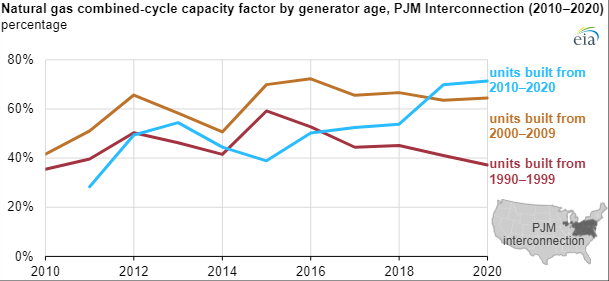Newer-Technology Natural Gas-Fired Generators Utilized More Than Older Units in PJM
By U.S. Energy Information Administration
The rapid development of shale gas resources in Pennsylvania, Ohio, and West Virginia has contributed to sustained low natural gas prices and encouraged the construction of natural gas-fired power plants. About one-third of the new natural gas-fired generating capacity built in the United States since 2010 is located in PJM Interconnection (PJM), the grid operator for all or parts of 13 states in the mid-Atlantic region, including Pennsylvania, Ohio, and West Virginia. In 2020, the utilization rate, called capacity factor, of natural gas-fired combined-cycle (NGCC) units built from 2010 to 2020 in PJM was 71%, which was higher than that of older units in the region.
Two factors affect the utilization of a combined-cycle natural gas generator: the efficiency of the generator and the delivered cost of natural gas. Newer NGCC generators use more efficient turbine technology and are generally larger than older units. Although all NGCC generators tend to increase or decrease utilization in response to changes in the price of natural gas, older units tend not to be used when natural gas prices rise because they are less efficient and more expensive to run than newer technology units.
EIA separates combined-cycle natural gas turbines in PJM into three groups, which reflect the turbine technologies available at the time they were built:
- Units built from 1990 to 1999
- B-, D-, and E-class gas turbines (GT) with 80 megawatt (MW)–110 MW capacity and average heat rates greater than 8,000 British thermal units per kilowatt hour (Btu/kWh) in combined-cycle mode
- Units built from 2000 to 2009
- First generation F-class GTs with 160 MW–190 MW capacity and average heat rates of 7,300 Btu/kWh in combined-cycle mode
- Units built from 2010 to 2020
- Next generation F-class GTs with 200 MW–225 MW capacity and average heat rates of 7,000 Btu/kWh in combined-cycle mode
- First generation advanced H- and J-class GTs with 265 MW–340 MW capacity and 6,700 Btu/kWh heat rates in combined-cycle mode
Grid operators, such as PJM, dispatch generators sequentially from lowest to highest cost. Because NGCC units built from 2010 to 2020 generally have the lowest operating costs, they are dispatched more frequently. Because of their lower efficiency, units built from 1990 to 1999 have higher operating costs and are more likely to be the marginal generators in the dispatch order, meaning they are the last combined-cycle generators to be dispatched.
Related News
Related News

- Energy Transfer to Build $5.3 Billion Permian Gas Pipeline to Supply Southwest
- Enbridge Sees High Demand to Expand 593-Mile Canada-to-U.S. Gulf Oil Pipeline
- 450-Mile Eiger Express Pipeline Gets Green Light for Permian-to-Gulf Natural Gas Transport
- Duke Energy to Sell Tennessee Gas Business, 3,800 Miles of Pipelines, for $2.48 Billion
- Energy Transfer’s Lake Charles LNG Project Wins Export Extension
- Enbridge Sees High Demand to Expand 593-Mile Canada-to-U.S. Gulf Oil Pipeline
- Strike Pioneers First-of-Its-Kind Pipe-in-Pipe Installation on Gulf Coast with Enbridge
- Trump Claims Japan, U.S. to Form Joint Venture for Alaska LNG Exports
- American Financiers Target Bulgarian Gas Storage Holding Russian Fuel
- Hungary to Start Talks with Qatar About Buying LNG





Comments